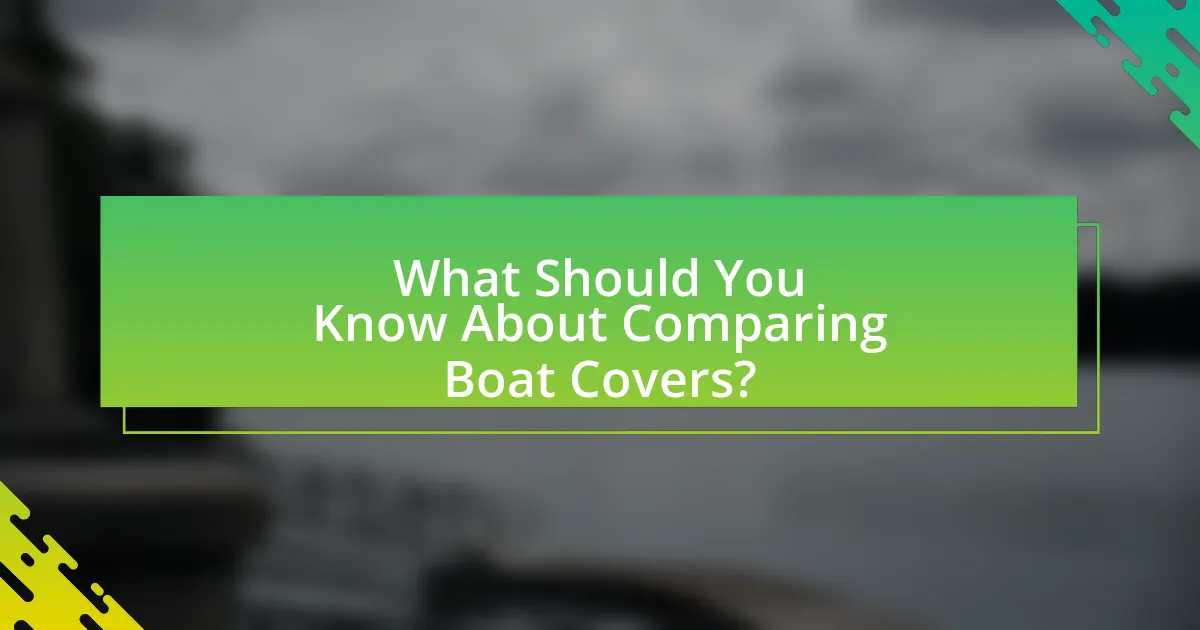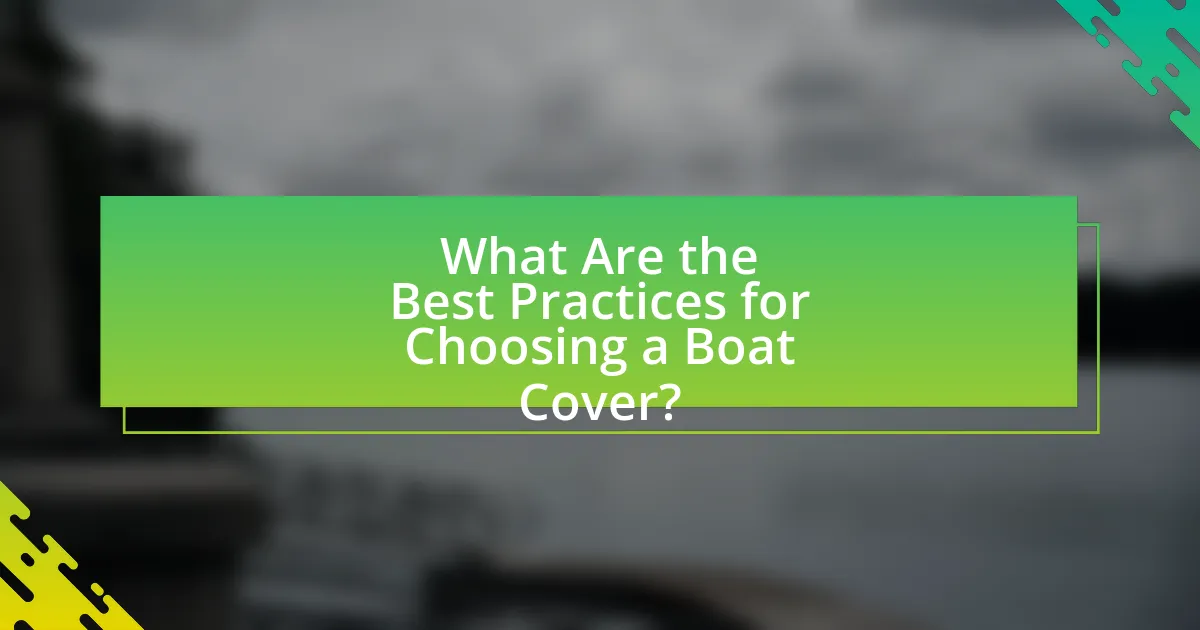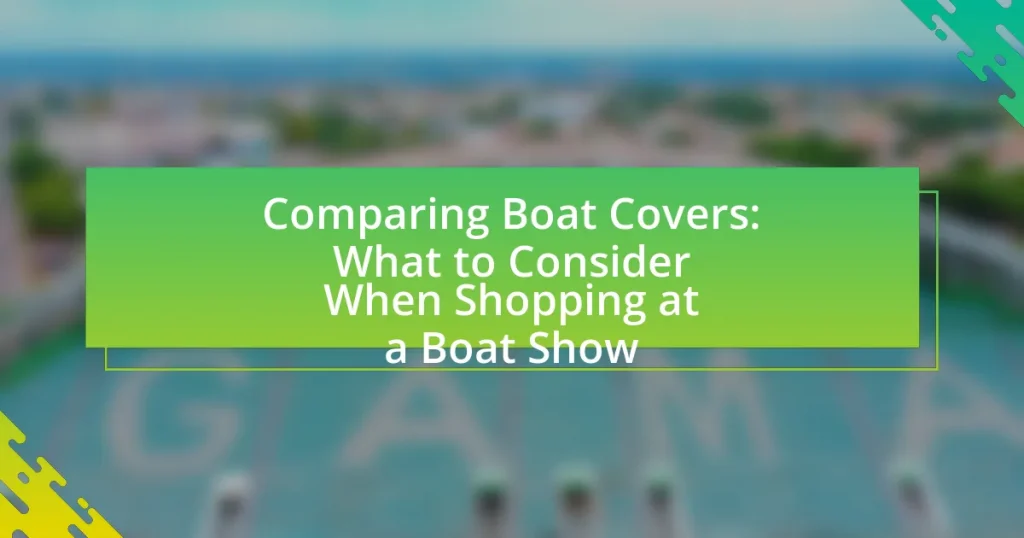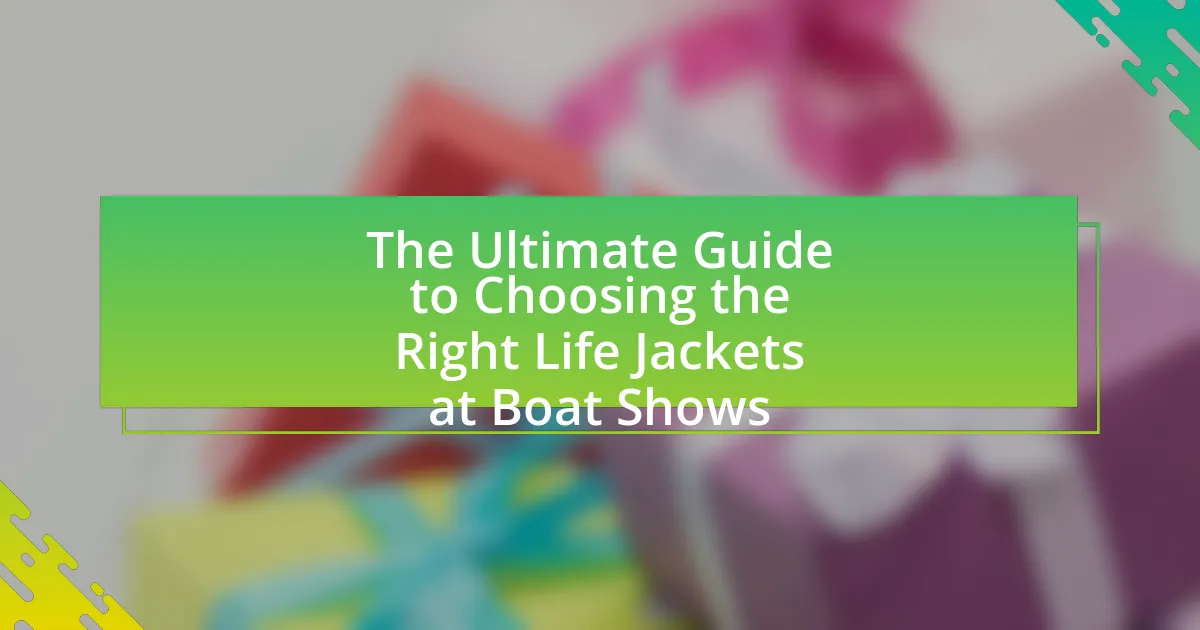The article focuses on comparing boat covers, emphasizing essential factors such as material quality, fit, durability, and UV protection. It highlights the importance of selecting the right cover to protect boats from environmental damage, mold, and mildew, while also discussing how climate influences cover choice. Various types of boat covers available at boat shows, including custom and universal options, are examined, along with features that enhance effectiveness. The article provides practical tips for shopping at boat shows, assessing quality, and maintaining boat covers to ensure longevity and optimal performance.

What Should You Know About Comparing Boat Covers?
When comparing boat covers, it is essential to evaluate factors such as material, fit, durability, and UV protection. High-quality materials like polyester or canvas provide better weather resistance and longevity. A proper fit ensures that the cover stays securely in place, preventing water accumulation and damage. Durability is crucial, as covers exposed to harsh conditions should withstand wear and tear over time. Additionally, UV protection is vital to prevent fading and degradation from sun exposure. These considerations are supported by industry standards that recommend specific materials and features for optimal boat cover performance.
Why is it important to choose the right boat cover?
Choosing the right boat cover is crucial for protecting the vessel from environmental damage, such as UV rays, rain, and debris. A well-fitted cover prevents mold and mildew growth, which can occur when moisture is trapped, and it also safeguards the boat’s finish and interior from fading and deterioration. According to the National Marine Manufacturers Association, proper boat maintenance, including the use of appropriate covers, can extend the lifespan of a boat significantly, ensuring that it remains in good condition for years.
What factors influence the effectiveness of a boat cover?
The effectiveness of a boat cover is influenced by material quality, fit, and design features. High-quality materials, such as marine-grade fabric, provide better resistance to UV rays, water, and mildew, ensuring durability and protection. A proper fit is crucial; covers that are too loose or too tight can lead to wear and inadequate protection against environmental elements. Additionally, design features like ventilation, straps, and reinforcements enhance the cover’s ability to withstand wind and rain, further contributing to its overall effectiveness.
How does the climate affect your choice of boat cover?
Climate significantly influences the choice of boat cover by determining the material and design needed for protection against environmental elements. For instance, in regions with high UV exposure, a cover made from UV-resistant fabric is essential to prevent fading and degradation. Conversely, in areas with heavy rainfall or snow, waterproof and breathable materials are crucial to prevent mold and mildew buildup. Additionally, extreme temperatures can necessitate insulation features to protect the boat’s surfaces. Therefore, selecting a boat cover tailored to the specific climate conditions ensures optimal protection and longevity of the vessel.
What types of boat covers are available at boat shows?
Various types of boat covers are available at boat shows, including full covers, trailerable covers, mooring covers, and custom-fit covers. Full covers provide complete protection for the entire boat, while trailerable covers are designed for use during transport, ensuring durability against wind and road debris. Mooring covers are intended for boats left in the water, offering protection from the elements. Custom-fit covers are tailored to specific boat models, ensuring a snug fit and optimal protection. These options cater to different needs and preferences, making boat shows a comprehensive venue for exploring cover choices.
What are the differences between custom and universal boat covers?
Custom boat covers are specifically designed to fit the exact dimensions and shape of a particular boat model, while universal boat covers are made to fit a range of boat sizes and styles. Custom covers provide a tailored fit that offers better protection against the elements, reducing the risk of water pooling and damage, whereas universal covers may not fit as snugly, potentially allowing for gaps that can lead to wear and tear. The precision of custom covers often results in higher durability and longevity, as they are crafted from materials suited to the specific boat’s needs, while universal covers are typically made from more generic materials that may not offer the same level of protection.
How do material types impact the durability of boat covers?
Material types significantly impact the durability of boat covers by influencing their resistance to environmental factors, wear, and tear. For instance, polyester and acrylic fabrics are known for their UV resistance and water repellency, which enhance longevity against sun damage and moisture. In contrast, materials like vinyl may offer waterproofing but can degrade under prolonged sun exposure. Additionally, high-denier fabrics provide greater strength and abrasion resistance, making them more durable in harsh conditions. Research indicates that boat covers made from solution-dyed fabrics maintain color and integrity longer than those made from standard dyed materials, further supporting the importance of material choice in durability.
What features should you look for in a boat cover?
When selecting a boat cover, look for features such as material durability, water resistance, UV protection, and proper fit. Durable materials like polyester or canvas ensure longevity, while water-resistant coatings prevent moisture accumulation. UV protection is crucial to safeguard the boat’s surface from sun damage, and a proper fit prevents flapping and wear during windy conditions. These features collectively enhance the cover’s effectiveness in protecting the boat from environmental elements.
How do waterproofing and UV protection vary among boat covers?
Waterproofing and UV protection among boat covers vary significantly based on the materials and construction techniques used. High-quality boat covers often feature advanced waterproof fabrics, such as polyester or nylon with waterproof coatings, which provide superior water resistance compared to lower-grade materials like canvas that may only offer basic water repellency. Additionally, UV protection is enhanced in covers treated with UV-resistant chemicals or made from materials specifically designed to block harmful sun rays, such as solution-dyed fabrics. For instance, covers with a UV rating of 50+ offer substantial protection against sun damage, while those without such treatments may degrade quickly under prolonged exposure. Therefore, when selecting a boat cover, it is crucial to consider both the waterproofing capabilities and the level of UV protection to ensure optimal durability and performance.
What are the benefits of breathable materials in boat covers?
Breathable materials in boat covers provide significant benefits, primarily by allowing moisture to escape while preventing water from entering. This characteristic helps to reduce mold and mildew growth, which can damage both the cover and the boat itself. Additionally, breathable materials enhance air circulation, which helps maintain the boat’s condition by preventing heat buildup and condensation under the cover. Research indicates that using breathable fabrics can extend the lifespan of boat covers and protect the underlying surfaces from deterioration caused by trapped moisture.

How Can You Effectively Shop for Boat Covers at a Boat Show?
To effectively shop for boat covers at a boat show, first, identify your boat’s specific dimensions and requirements, as this ensures you select a cover that fits properly. Next, compare materials and features of different covers, focusing on durability, water resistance, and UV protection, which are critical for long-term use. Additionally, engage with vendors to ask about warranties and maintenance tips, as reputable manufacturers often provide valuable insights that can influence your decision. Finally, take note of pricing and any promotional offers available at the show, as boat shows frequently feature discounts that can lead to significant savings.
What questions should you ask vendors about boat covers?
When inquiring about boat covers, ask vendors specific questions such as: “What materials are used in the construction of the boat cover?” This question is crucial because the material determines durability, weather resistance, and UV protection. Additionally, inquire, “What is the warranty period for the boat cover?” A warranty indicates the manufacturer’s confidence in their product and provides assurance for the buyer. Another important question is, “Is the cover custom-fit for my boat model?” Custom-fit covers offer better protection and fit compared to universal options. Lastly, ask, “How do I properly maintain and clean the boat cover?” Understanding maintenance requirements ensures longevity and performance of the cover.
How can you assess the quality of a boat cover on display?
To assess the quality of a boat cover on display, examine the material, stitching, and fit. High-quality boat covers are typically made from durable, weather-resistant fabrics like polyester or canvas, which provide protection against UV rays and moisture. Inspect the stitching for tightness and uniformity; double-stitched seams indicate better durability. Additionally, ensure the cover fits snugly over the boat, as a proper fit prevents water pooling and reduces wear. These factors collectively indicate the overall quality and longevity of the boat cover.
What warranties or guarantees should you look for?
When shopping for boat covers, look for warranties that include a minimum of five years of coverage against defects in materials and workmanship. A solid warranty indicates the manufacturer’s confidence in their product’s durability and quality. Additionally, consider guarantees that cover UV resistance and waterproofing, as these features are critical for protecting your boat from environmental damage. Research shows that boat covers with extended warranties often reflect higher quality standards, as manufacturers are willing to stand behind their products for longer periods.
How can you compare prices and options at a boat show?
To compare prices and options at a boat show, attendees should gather information from multiple vendors and analyze the specifications of various boat covers. This involves taking notes on the prices, materials, and features of each cover while asking vendors about warranties and additional services. By comparing these details side by side, buyers can make informed decisions based on value and suitability for their needs. Additionally, utilizing online resources or mobile apps to check prices and reviews can enhance the comparison process, ensuring that attendees are aware of market trends and average costs.
What strategies can help you negotiate the best deal?
To negotiate the best deal, research the market value of boat covers and understand the features that differentiate them. Knowledge of comparable products empowers you to make informed offers and counteroffers. Additionally, establishing a budget and being willing to walk away if the deal does not meet your criteria can strengthen your negotiating position. According to a study by the Harvard Business Review, effective negotiators often prepare by gathering data on pricing and competitor offerings, which leads to more favorable outcomes.
How do you determine if a price is fair for a boat cover?
To determine if a price is fair for a boat cover, compare the price against the average market rates for similar covers based on material, size, and brand. Research indicates that boat covers typically range from $100 to $500, depending on these factors. For instance, a high-quality, custom-fit cover made from durable materials may cost more than a generic, universal fit cover. Additionally, check customer reviews and ratings to assess the value and durability of the cover, as well as warranty offerings, which can indicate the manufacturer’s confidence in their product.

What Are the Best Practices for Choosing a Boat Cover?
The best practices for choosing a boat cover include selecting the right material, ensuring a proper fit, and considering the cover’s UV resistance and waterproof capabilities. High-quality materials like polyester or canvas provide durability and protection against the elements. A cover that fits snugly prevents water pooling and debris accumulation, which can damage the boat. Additionally, UV resistance is crucial for protecting the boat’s surface from sun damage, while waterproof features ensure that rain and moisture do not penetrate the cover. These practices are supported by industry standards that emphasize the importance of material quality and fit for effective boat protection.
How can you ensure the right fit for your boat cover?
To ensure the right fit for your boat cover, accurately measure your boat’s dimensions, including length, width, and height. This precise measurement is crucial because boat covers are designed to fit specific sizes, and a cover that is too large or too small can lead to inadequate protection. According to the National Marine Manufacturers Association, using a cover that fits properly can prevent damage from UV rays, rain, and debris, thereby extending the lifespan of your boat. Additionally, consider the boat’s shape and any accessories, such as towers or rails, which may affect the fit.
What measurements should you take before shopping?
Before shopping for boat covers, you should take measurements of your boat’s length, width, and height. Accurate length measurement should be taken from the tip of the bow to the stern, while width should be measured at the widest point of the boat. Height should be measured from the ground to the highest point of the boat, which is often the top of the windshield or any other protruding feature. These measurements ensure that you select a cover that fits properly, preventing damage and wear caused by ill-fitting covers. Proper fit is crucial, as a cover that is too loose can allow water and debris to accumulate, while one that is too tight may be difficult to secure and could damage the boat’s surface.
How do you account for accessories and features when measuring?
When measuring for boat covers, accessories and features must be accounted for by including their dimensions in the overall measurement. This means measuring not only the boat’s length and width but also considering items such as railings, cleats, and any other protruding features that may affect the fit of the cover. Accurate measurements ensure that the cover will accommodate these accessories, preventing issues like wear or damage during use. For instance, if a boat has a tall windshield or additional equipment mounted on it, these should be factored into the height and width measurements to ensure a proper fit.
What tips can help you maintain your boat cover?
To maintain your boat cover effectively, regularly clean it with mild soap and water to prevent mold and mildew buildup. This cleaning routine is essential because dirt and organic materials can degrade the fabric over time, leading to premature wear. Additionally, ensure that the cover is properly secured to prevent flapping in the wind, which can cause tears. Using a breathable cover can also help reduce moisture accumulation underneath, further protecting your boat. Regular inspections for signs of damage, such as fraying or holes, allow for timely repairs, which can extend the life of the cover significantly.
How often should you clean and inspect your boat cover?
You should clean and inspect your boat cover at least once a month. Regular monthly cleaning helps remove dirt, debris, and mildew, which can degrade the material over time. Additionally, inspecting the cover monthly allows you to identify any wear, tear, or damage that could compromise its effectiveness in protecting your boat. This frequency is supported by best practices in boat maintenance, which emphasize the importance of upkeep to prolong the lifespan of marine accessories.
What storage practices extend the life of your boat cover?
To extend the life of your boat cover, proper storage practices include cleaning the cover before storage, ensuring it is completely dry, and storing it in a cool, dry place away from direct sunlight. Cleaning removes dirt and contaminants that can degrade the material, while drying prevents mold and mildew growth. Storing in a cool, dry environment protects the cover from UV damage and extreme temperatures, which can cause wear and tear. These practices are supported by industry guidelines that emphasize the importance of maintenance and environmental protection for marine fabrics.






